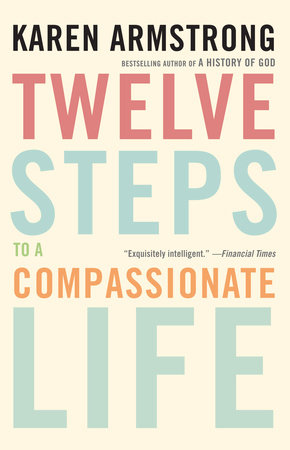Twelve Steps to a Compassionate Life
Book Author – Karen Armstrong
Book Publication Date – December 28, 2010
Book Publisher – Knopf
Print Length – 240 pages
Book Description
“One of the most original thinkers on the role of religion in the modern world—author of such acclaimed books as A History of God, Islam, and Buddha—now gives us an impassioned and practical book that can help us make the world a more compassionate place.
Karen Armstrong believes that while compassion is intrinsic in all human beings, each of us needs to work diligently to cultivate and expand our capacity for compassion. Here, in this straightforward, thoughtful, and thought-provoking book, she sets out a program that can lead us toward a more compassionate life.
The twelve steps Armstrong suggests beginning with “Learn About Compassion” and close with “Love Your Enemies.” In between, she takes up “compassion for yourself,” mindfulness, suffering, sympathetic joy, the limits of our knowledge of others, and “concern for everybody.” She suggests concrete ways of enhancing our compassion and putting it into action in our everyday lives, and provides, as well, a reading list to encourage us to “hear one another’s narratives.” Throughout, Armstrong makes clear that a compassionate life is not a matter of only heart or mind but a deliberate and often life-altering commingling of the two.”
Book reviews available, including from The Guardian and goodreads.
Reflection Questions
- What is my biggest takeaway from “Twelve Steps to a Compassionate Life” by Karen Armstrong?
- Which step do I find easiest to apply in my life?
- Which step do I find the most challenging?
- In what areas of my life do I need to be more compassionate?
- In what ways can I develop more self-compassion to build a stronger foundation of loving kindness that I can then share with the world?
- What is my biggest vision for my life in regard to living with compassion?
- How will I feel when I am living a compassionate life?
Learning Resources
- Peaceful Readers “Twelve Steps” Information Sheet
- Peaceful Readers “Twelve Steps” Presentation
- Charter for Compassion website
- Charter for Compassion animation (4 min.)
- Charter for Compassion launch, Berkley Center for Religion, Peace & World Affairs at Georgetown University (60 min.)
- Karen Armstrong Biography on Britannica
- Karen Armstrong on Twitter
- Karen Armstrong on Facebook
- Video – Karen Armstrong on Oprah’s SuperSoul Sunday (2 min.)
- Video – Karen Armstrong TED Talk (22 min.)
- Video – Compassion in Action, Karen Armstrong at the Dalai Lama Center for Peace and Education (22 min)
- Video – How Little We Know, Empathy and Compassion in Society 2013 (17 min.)
- Video – Compassion Talk, 2016 Festival of Faiths, “Sacred Wisdom, Pathways to Nonviolence” (32 min.)
Action Recommendations
- Sign the Charter for Compassion and invite your friends to do the same.
- Examine the teachings of your own religious or secular tradition about compassion.
- For the next month, keep a journal of notes, passages, poems, thoughts on what you learn about compassion (see book page 27).
- Look at what’s happening in your family, school, workplace, religious community, penal institutions, etc. What teachings, practices, or policies contribute to a lack of compassion? Identify ways you might help bring them to light and/or change them—whether it’s writing a letter to the editor of the local paper, creating a curriculum on compassion, starting a mediation program in the schools, or whatever action resonates with you.
- Make a list of your positive qualities, good deeds, talents, and achievements.
- Our own suffering often increases our compassion for others. Acknowledge the difficulties and suffering you’ve endured and how you used or might use your experience to help others. For instance, if you’ve experienced a serious illness or took care of someone who did, consider volunteering to help others navigate a similar circumstance.
- Practice the Buddha’s meditation on the four immeasurable minds of love (see book page 85).
- Spend a day ―tuning into how people around you are feeling.
- It is often difficult to witness suffering and to engage with someone in distress, especially when we are preoccupied with our own concerns. Notice, over the next month, when you want to turn away. Instead, remember how it feels to be hurt, depressed, angry, helpless, and distraught. Then remember what it was like to have someone be kind and caring toward you. Offer that person a kind gesture (see book pages 101–102).
- If you are not familiar with mindfulness meditation, check out one or more books listed in Twelve Steps to a Compassionate Life Suggestions for Further Reading (see page 215).
- Set a time each day to try one or more of these meditations.
- Make a resolution to act once every day in accordance with the positive version of the Golden Rule: “Treat others as you would wish to be treated yourself”
- Follow the three steps Armstrong lays out on pages 128–130.
- Read through Armstrong’s questions on pages 141–142 to help you analyze and be more mindful of the way you approach discussions and arguments.
- Follow Armstrong’s suggestions on pages 148–149 for expanding your mindfulness practice to encompass the way you think and speak about people from other countries, cultures, ethnic groups, or religions.
- Follow the directions on page 186 to ―investigate your enemy. Notice how you feel before and after the exercise. Do you view your ―enemy any differently? What has changed?
Do Something Right Away to Increase Peace
Subscribe to our YouTube channel
Give a gift of money to support Peace Through Action’s mission delivery activities
Choose opportunities to take part in our #PeaceBeginsWithWe campaign

